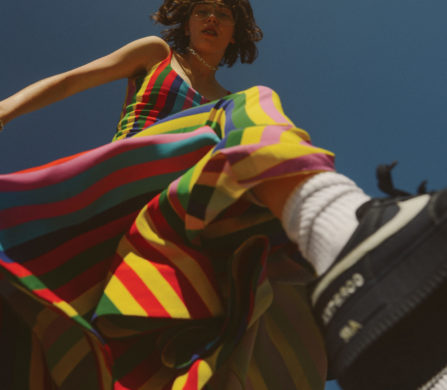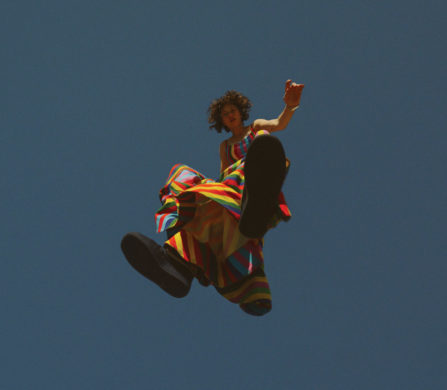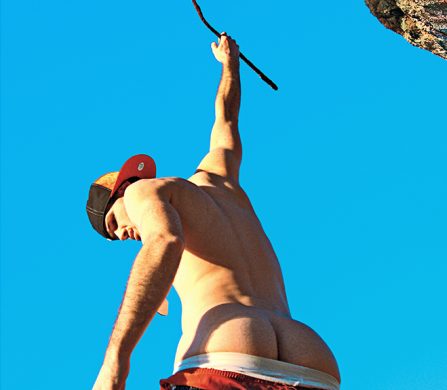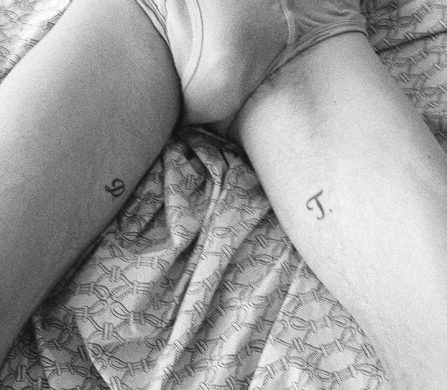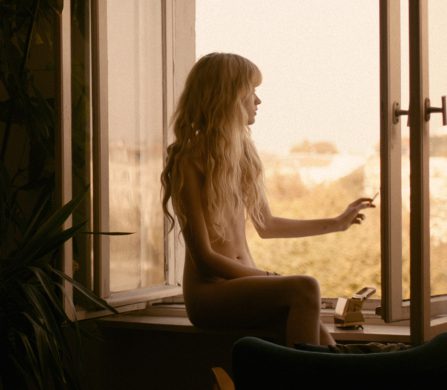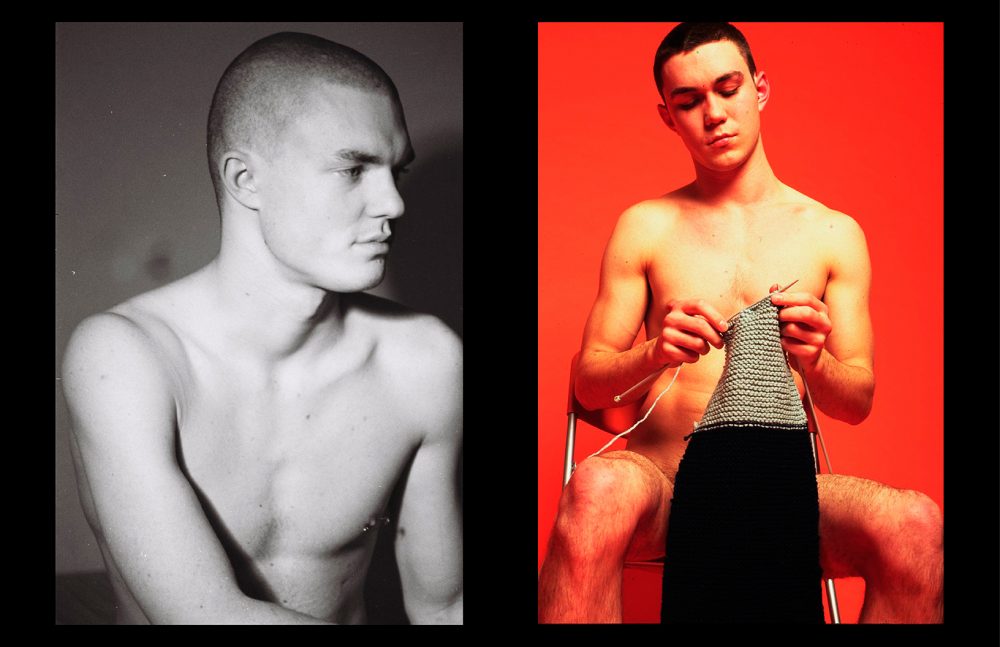
BRUCE LABRUCE, KLAUS VON BRUCKER #2 (NO SKIN OFF MY ASS PRODUCTION STILL), 1990
Opposite
BRUCE LABRUCE, NAKED BOY KNITTING, 2002
Feeding off taboos and political incorrectness, Bruce LaBruce has been at the forefront of the gendercore movement for more than three decades —but that hasn’t tamed his transgressive vision. Hailing from Toronto, his work has been dubbed as “anti-authoritarian, counter-cultural, polemical, and subversive” by none other than himself. Sublime, subversive and more than suggestive, LaBruce is one the greatest idiosyncratic talents of the LGTBQ+ community; exuding stoicism, charged with political force and never failing to disrupt and dispel the myths and kinks surrounding pornography and sexuality’s status quo.
Following retrospective gallery exhibitions and programs in London, Madrid, L.A. and New York, the Tom of Finland Store loses its exhibition virginity presenting LaBruce’s ‘FAGGOTRY’. Now taking over the Internet, the ground-breaking digital exhibition features over 100 photographs that LaBruce has produced over the past twenty-five years —from film sets from his iconoclastic films such as No Skin Off My Ass, Super 8 ½ or L.A. Zombie, to candid shots of fellow artists and work for porn magazines Honcho, Playguy, and Inches from the late 90s and early 00s. We caught up with the writer, filmmaker, photographer, director and pornographer to talk about ‘FAGGOTRY‘s genesis, punk conformity, queer radicalism and his latest film ventures.
The online reiteration of ‘FAGGOTRY‘ follows retrospective gallery exhibitions and programs in London, Madrid, Los Angeles and New York. How did the exhibition first come about?
I was contacted by Danny Fuentes in 2016 to do a show at his gallery Lethal Amounts in Los Angeles, a really cool punk rock space downtown. I thought it would be a great opportunity to do a retrospective show, so I dug into my archives and had digital files made from negatives and diapositives that had never been digitized before, going back 25 years. I also included some new and previously unpublished material. I mounted a variation on the show in Madrid in 2017 at my gallery there, La Fresh, where I had my scandalous ‘Obscenity’ photography show in 2012. Then Bren O’Callaghan and Andrew Ellerby did yet another variation of the show in London this past October at Gallery 46 under the title ‘The Haus of Bruce LaBruce’. I had a retrospective of my films at MoMA in 2015, so that was the genesis of it all. A number of the photos included in ‘FAGGOTRY‘ were taking on my film sets over the years, including No Skin Off My Ass, Super 8 ½, Hustler White, Skin Flick, The Raspberry Reich, Otto; or, Up with Dead People, and L.A. Zombie.
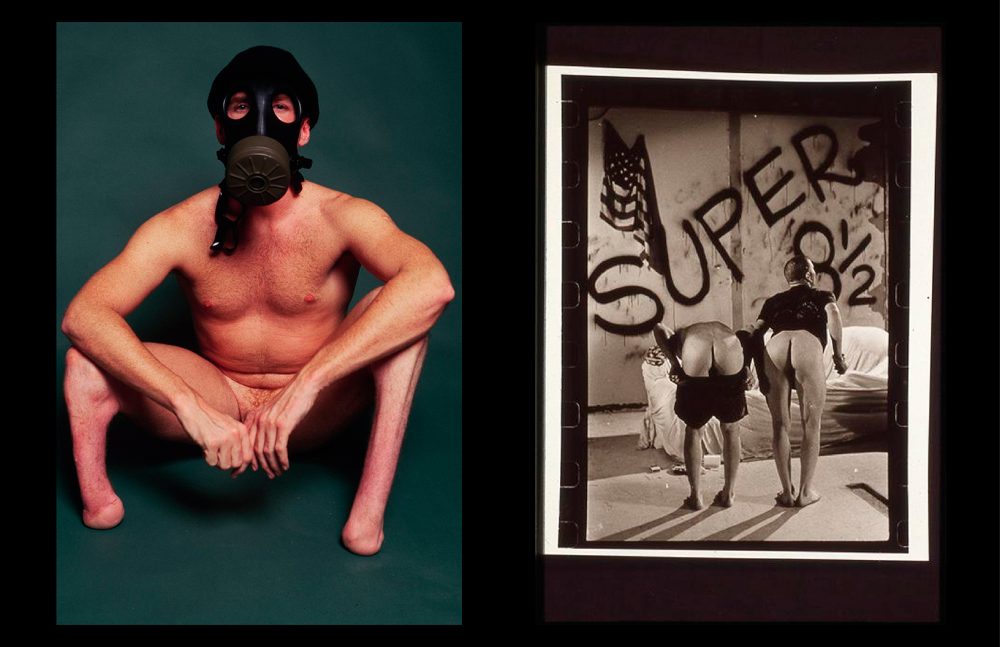
BRUCE LABRUCE, AMPUTEE WITH GAS MASK, 1999
Opposite
BRUCE LABRUCE, TWO MOONS (SUPER 8 ½ PRODUCTION STILL), 1994
The online exhibition features 100 photographs that you’ve produced over the past twenty-five years. How did you set out to make the selection?
It wasn’t easy to narrow them down! We tried to make a selection that covered a broad range of my photographic work: film stills and behind-the-scenes publicity shots, photos taken for gay porn magazines like Honcho and Playguy, candid portraits of friends and a few celebs, live performance shoots at my gallery openings, portraits taken for magazines, and some fashion work.
Do you have any particular favourites?
It was fun to dig up some old photos I took of Ryan McGinley, Dan Colen, and the late, great Dash Snow when I was hanging out with them a lot in New York in the late nineties, which I’ve never displayed before. I also love the Hustler White behind-the-scenes shots, which have also never been shown previously.
Your work is notoriously known to strive for polemic. Why did you decide to name the exhibition ‘FAGGOTRY‘? What does that word mean to you nowadays?
There used to be a Canadian gay magazine called Fags and Faggotry, I title I always loved, so it’s partly cribbed from that. I’ve always liked the word faggot as an antidote to all the politically correct language that people, especially on the left, are constantly tip-toeing around. Of course, etymologically, faggot was also a word for a bundle of sticks, twigs or branches bound together which they conveniently used to burn witches and homosexuals at the stake in the Middle Ages! Faggotry also has an element of chicanery to it, like Buggery (“to bugger” also referring to anal sex), in the sense of fucking with things, committing pranks, mischief. Maybe I will call my next show Buggery!
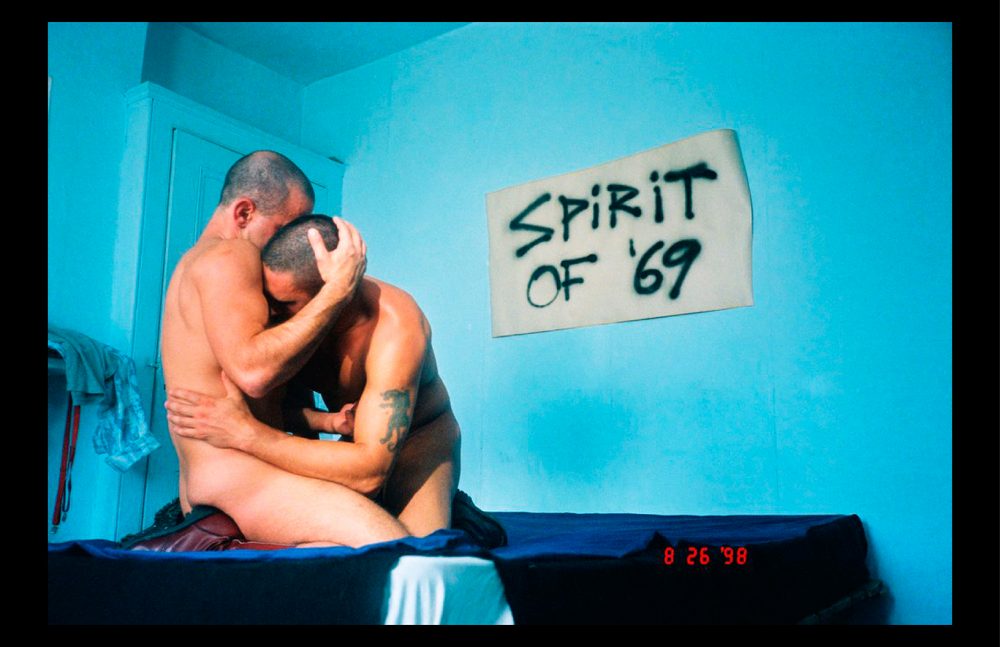
BRUCE LABRUCE, SPIRIT OF ’69, 1998
The special edition of prints is exclusive to ToFS. Why did you decide to collaborate?
I’ve been a big fan of Tom of Finland since the eighties. For the queer punk fanzine, J.D.s, that I co-edited with G.B. Jones in the late eighties/early nineties, G.B. did a detournement of Tom’s drawings, substituting hot girls for the men, which was called Tom Girls. I had the great pleasure of having a screening of a few of my films at The Tom of Finland House the summer before last, and I was invited to a couple of great dinners there and a tour of the house. ToF is really expanding its brand to include the promotion and archiving of queer work that presents gay sex in sexy and challenging ways like Tom of Finland did. So a collaboration with them seemed almost inevitable!
In the past, you’ve implied that you feel the Internet has democratized porn and made it more disposable and less creative. Why do feel that way?
I’m not sure I said that exactly. I think the democratization of porn that resulted from the digital revolution and the internet has its good and bad aspects. It’s great that there are so many non-professionals who are able to express themselves sexually on the internet, challenging the primacy of industry porn, which tends to be pretty monolithic. Different styles of bodies and sexuality, innovative aesthetics, and a whole new world of fantasies have opened up porn to a much broader audience. It has also challenged people making more standard industry porn to catch up with the trends, to use social media creatively, and to not be so rigid, so to speak. The downside is that the field is so overdetermined now that you have to weed through a lot of crap to get to the gold!
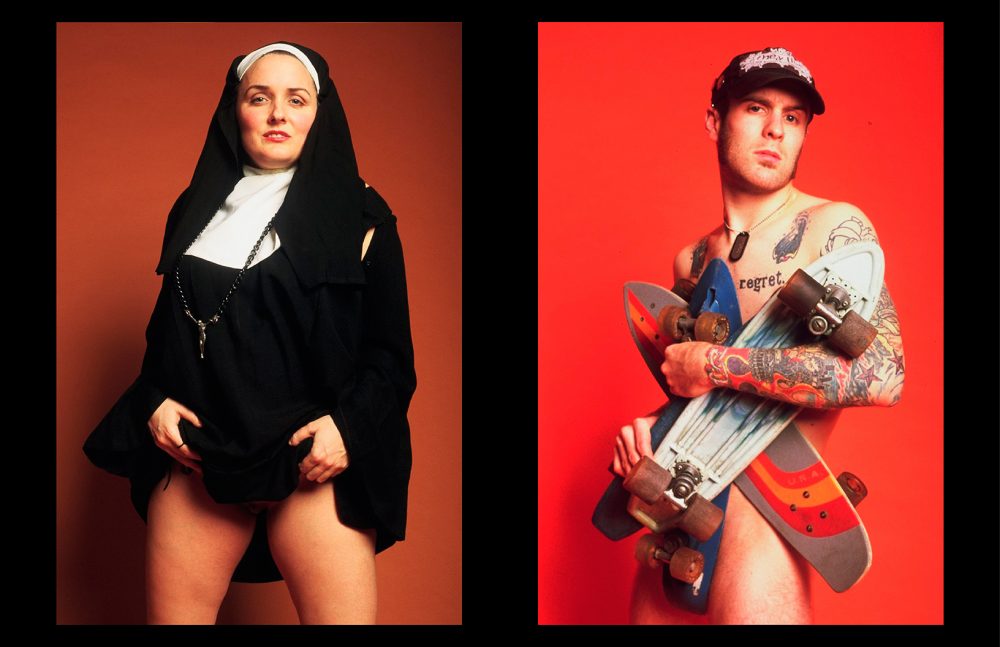
BRUCE LABRUCE, NUNSPLOITATION, 2002
Opposite
BRUCE LABRUCE, SKATEBOARD DRESS, 2005
You’ve often been dubbed a punk photographer, do you feel like the definition of punk remains the same or that we’ve lost the spirit along the way?
Punk will never have the same meaning that it originally had. In the eighties, when people started sporting Mohawks, getting tons of tattoos and piercings, and generally looking like freaks from another planet, the shock value was enormous. It was easy back then to scare the living daylights out of people. It was threatening and provocative. It was also before the internet and social media, so it really was all about tribes that had to seek each other out through fanzines and punk shows. It was a much more rarefied scene, a true underground —anti-corporate, anti-authoritarian, anti-capitalist, anarchic, and aggro. But by the mid-nineties, people had become used to the aesthetic, everyone started getting tattoos and piercings, and fashion and the mainstream media had co-opted the punk style, diffusing it and emptying of it of its original countercultural significance. (There was a line of Gucci shoes recently called Queercore!) But I like to think I maintain a punk ethos in my work in terms of style and strategy, which entails being provocative and shocking, acknowledging ambivalence, being ambiguous, questioning authority, and challenging the conventions and norms of society and cinema.
You are also about to release the anthology ‘It Is Not The Pornographer That Is Perverse…’. What can you tell about them and when can we expect the first one to come out?
‘It Is Not The Pornographer That Is Perverse…’ is an anthology or omnibus movie that I made for the porn company Cockyboys. I approached them about a collaboration, and I proposed four short films with interrelated themes using a combination of the porn actors they have in their stable and non-professional performers. There are four films, the first two of which —Diablo in Madrid and Uber Menschen—were shot in Madrid and the second two —The Purple Army Faction and Fleapit— which were shot in Berlin. The Madrid films feature porn stars Allen King, Sean Ford, Colby Keller, and Calvin Banks, and the Berlin films feature Francois Sagat, Dato Foland, Arad Winwin and Levi Karter, as well as porn star AJ Alexander. The films are all a bit crazy, drawing from themes and aesthetics I’ve developed over the years in my work. ‘It Is Not…’ will be shown at queer festivals starting in the next couple of months, while the longer version, called ‘Bruce LaBruce’s Fleapit,’ will soon be available from Cockyboys online.
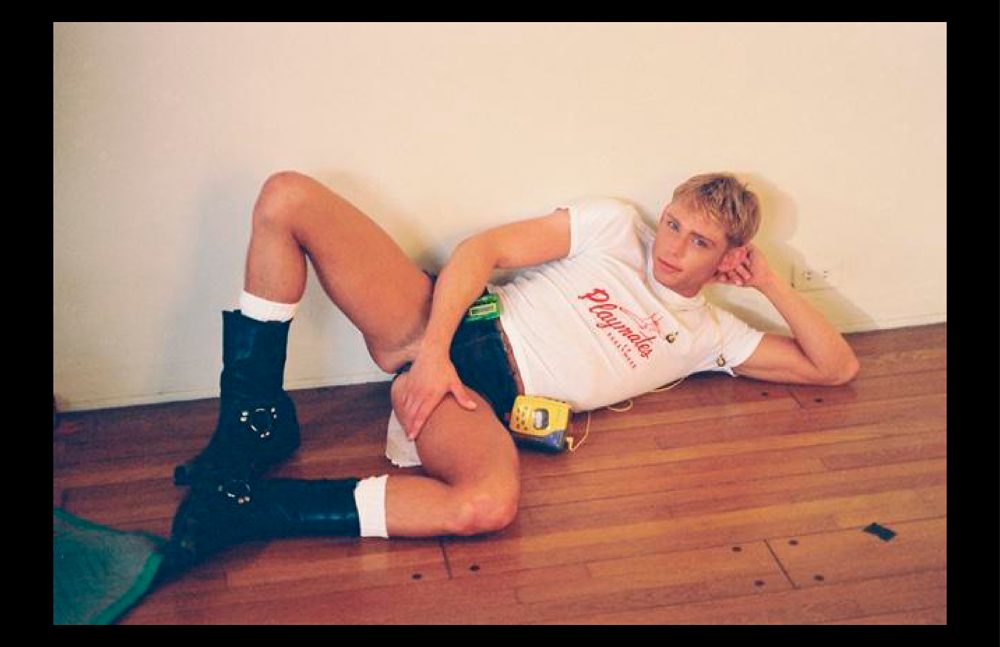
BRUCE LABRUCE, PLAYMATES (ON THE SET OF HUSTLER WHITE), 1995
You are working on your next project ‘Twincest’ and have also been working alongside Quebecois screenwriter Martin Girard on ‘Saint-Narcisse’, which will be supported by SODEC. What can you tell us about that?
‘Twincest’ was actually the working title of ‘Saint-Narcisse’. ‘Saint-Narcisse’ is a loose re-telling of the Narcissus myth set in rural Quebec in the early seventies. It’s about a young man who goes on a quest to find his mother, who may or may not be dead. He finds her living in the woods with a mysterious young girl, but he also discovers that he has an identical twin from whom he was separated at birth and who was raised by monks. Much mystery and drama and sexual shenanigans ensue! It’s a larger-budgeted film that we still need to finish financing, so it won’t be made for a while…
You’ve worked a lot in Spain in the last years and in 2012 you had a problem with an ultra-catholic group that violently attacked one of your exhibitions at La Fresh Gallery. Do these protests and criticism ever deter you from disrupting the status quo of modern sexuality or do they push you to work even harder?
My show ‘Obscenity’ at La Fresh Gallery in Madrid really caused a national ruckus in Spain in 2012. The Mayor tried to shut down the show, there were Catholic protesters outside every day, and the day after the opening someone through an explosive device through the front window of the gallery! It was both exhilarating and scary! The show was about the intersection between religious and sexual ecstasy, using a lot of Catholic imagery. The gallery really supported me and the show, and I stand by the work. There are much hypocrisy and sexual repression in the Catholic Church which has a lot of negative effects, including sexual abuse, homophobia, and the spread of AIDS owing to their refusal to promote condoms and birth control. But everyone knows that the history of Catholic saints is like a compendium of sexual fetishes! It’s always good to challenge powerful institutions that are retrograde and reactionary, and at the same time acknowledge and celebrate its sexual perverseness!
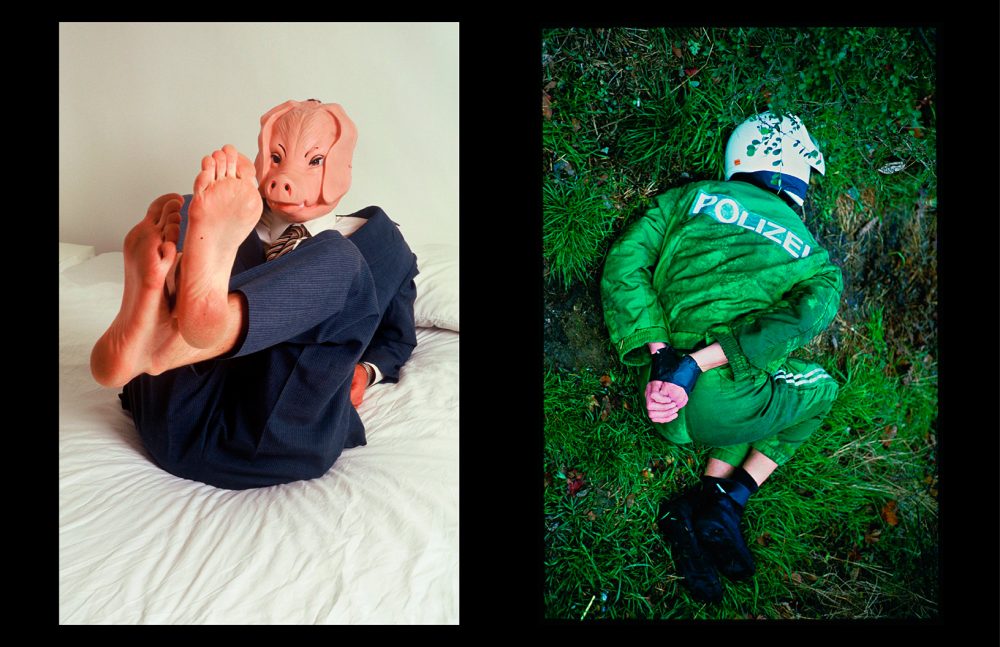
BRUCE LABRUCE, PIG’S FEET, 2001
Opposite
BRUCE LABRUCE, POLIZEI, 2004
Your latest film, ‘The Misandrists’, tackled the issue of patriarchy but wasn’t accepted particularly well by most LGTBQ+ film festivals and you even deemed it a “failed strategy”. Why do you feel that is?
Did I call it a failed strategy? Lol, I’m not sure about that! ‘The Misandrists’ does challenge the patriarchy, but it is also a critique of certain kinds of anti-sex, anti-porn feminism that shames people for expressing their sexuality in unorthodox ways. Concurrent with the rise of the fascist right is a kind of neo-Stalinism on the left that attempts to police desire and language and censor the free expression of ideas, particularly around sexuality. So the film embraces some aspects of the feminist movement, but also affectionately critiques other aspects of it, particularly the rejection of transwomen evinced by some second wave feminists. It’s designed as a polemic, and it really divides audiences, like all my work.
Why do you feel words like “gay” and “feminism” have become buzzwords and generic? What can we do as a society to tackle the loss of critical thinking when it comes to queer rights and feminism?
The early roots of both the gay and feminist movements were countercultural and radical, challenging the status quo in terms of sexual roles and expression. They were liberation movements that fought against all sorts of patriarchal institutions, including capitalism, organized religion, monogamy, and marriage. Now we are at a point where both movements have moved deeply into assimilation, distancing themselves from their original radicalism in order to gain equal participation in the same corrupt systems they once considered their mortal enemies! So it’s time to let go of these co-opted movements identified as “gay” and “feminist” and come up with new revolutionary movements and strategies!
Lastly, you created Bruce LaBruce as a Warholian-like persona when you first started working in the industry. Do you feel like your intentions have changed along the way? How would you describe Bruce LaBruce in 2018?
I did create Bruce LaBruce as a Warholian-like persona filtered through situationist strategies, and at one point in the nineties, I kind of lost track of where the “authentic” me ended and the artificial construction began. My film Super 8 ½ documents this identity crisis, but after the quasi-nervous breakdown it induced, I emerged as someone who had reconciled the two or more personae he had developed into an integrated whole, more or less! I still keep much of my private life private, but both me and my Frankenstein’s monster, Bruce LaBruce, are much more comfortable in the skins they share, stitched together after years of combat in the culture wars!
Bruce LaBruce’s ‘FAGGOTRY‘ exhibition and its special edition of prints are available exclusively at ToFS until June 11th, 2018.
All images courtesy of the artist and Tom of Finland Store.
Words / Sara Delgado
Discover the latest issue of Schön!.
Now available in print, as an ebook, online and on any mobile device.













